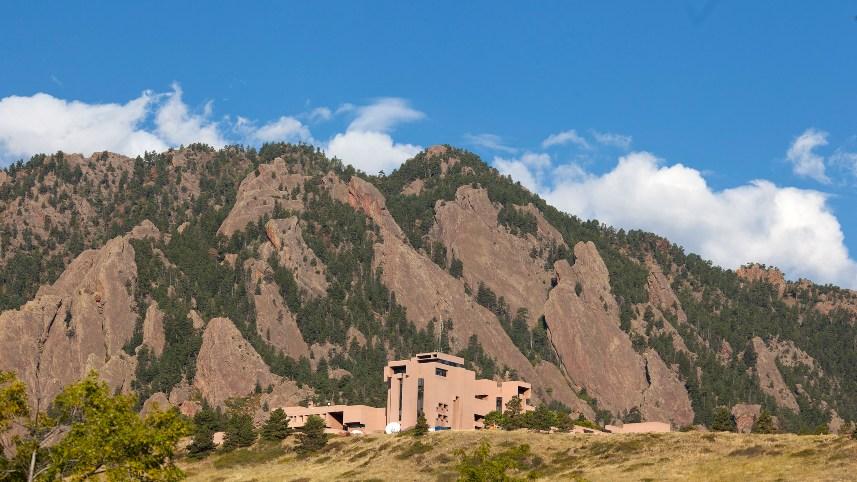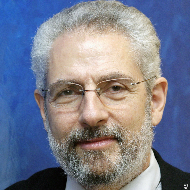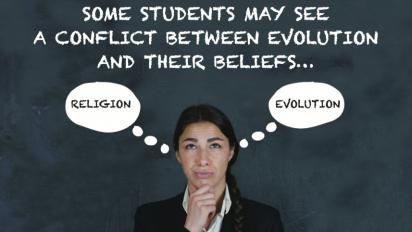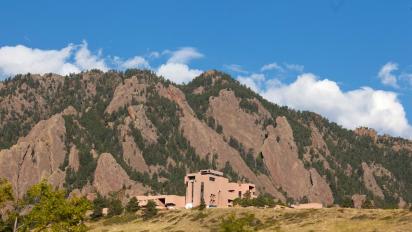Boulder 1965: Is the climate unstable?
In this Place and Time article, Spencer Weart recounts a meeting of scientists in 1965, little noticed at the time, that "marked a revolution in climate science."

The National Center for Atmospheric Research Mesa Laboratory in Boulder, Colorado. Copyright University Corporation for Atmospheric Research.
Boulder, Colorado, is a university town with majestic views of a sandstone scarp to the west and summer thunderstorms stalking the plains to the east. It is a premier center for the study of climate (although I admit I went there because it is also a center for mountaineering and skiing). Alongside the university science departments there is the High Altitude Observatory, studying the sun since 1940, and the gorgeous laboratories of the National Center for Atmospheric Research designed by master architect I. M. Pei. The buildings were under construction in August 1965 when a small conference on “Causes of Climate Change” convened in Boulder. Scarcely noticed at the time, in retrospect the meeting marked a revolution in climate science.
The organizers deliberately brought together scientists from a fantastic diversity of fields, experts in everything from sunspots to volcanoes. Presiding over the meeting was an oceanographer, Roger Revelle. Lectures and roundtable discussions boiled with spirited debate as rival theories clashed; Revelle needed all his exceptional leadership skills to keep the meeting on track. Convened mainly to discuss explanations of the ice ages, the conference featured a burst of new ideas about physical mechanisms that could bring something few had thought possible: abrupt climate change.
Invited to give the opening address was a pioneer of computer meteorology, Edward Lorenz. It would not be until 1979 that he asked, “Does the flap of a butterfly’s wings in Brazil set off a tornado in Texas?” But already in 1961 a lucky accident had pointed Lorenz to the effect. His computer model was producing impressive simulacra of evolving weather patterns, worked out to six decimal places. One day he needed to repeat a calculation and for convenience entered only the first three digits of the initial conditions. He was shocked to see that over a few simulated weeks the weather pattern diverged radically from his original result. In Boulder, Lorenz reported that the slightest change of conditions could produce a massive transformation in an atmospheric system.
Nobody had yet imagined a mechanism that might push the planet abruptly into a state geologists had seen farther in the past, when palm trees flourished on the coasts of Antarctica.
A geochemist brought related evidence. Wallace Broecker told how he used radioactive isotopes to date fossil coral reefs perched at various elevations, getting a timetable for how the sea level had changed as continental ice sheets built up and melted away. His dating of ice ages, to almost everyone’s surprise, neatly matched a timetable proposed decades earlier in astronomical calculations by a Serbian mathematician, Milutin Milankovitch. The subtle changes in sunlight calculated from periodic shifts in Earth’s orbit seemed insignificant. Yet somehow the tiny shifts governed ice ages. “The Milankovitch hypothesis,” Broecker now declared, “can no longer be considered just an interesting curiosity.” As others brought up additional observations and theories, the conference members began to speculate how the climate system could be so delicately balanced that a small push could “trigger” a switch between altogether different states.
By the end of the conference the experts had reached consensus on some points. In a summary, the respected climatologist Murray Mitchell reported that minor changes in the past “may have sufficed to ‘flip’ the atmospheric circulation from one state to another.” Our “comparatively amicable interlude” of warmth could give way to another ice age, he warned, and perhaps faster than had been supposed. It was a natural concern when for millions of years Earth’s climate had oscillated between moderate warmth and glacial cold. Scientists were only beginning to think about the rise of human greenhouse gas emissions. Nobody had yet imagined a mechanism that might push the planet abruptly into a state geologists had seen farther in the past, when palm trees flourished on the coasts of Antarctica.
Today the IPCC’s scientists warn that unless we stop pushing global temperature higher with our emissions, an onset of unstoppable feedbacks that force the temperature to an intolerable height “cannot be ruled out.” But already in 1965 climate experts had walked away from the traditional and comfortable belief that climate could change only slowly over many centuries. The system is not so stable.
This version might differ slightly from the print publication.






